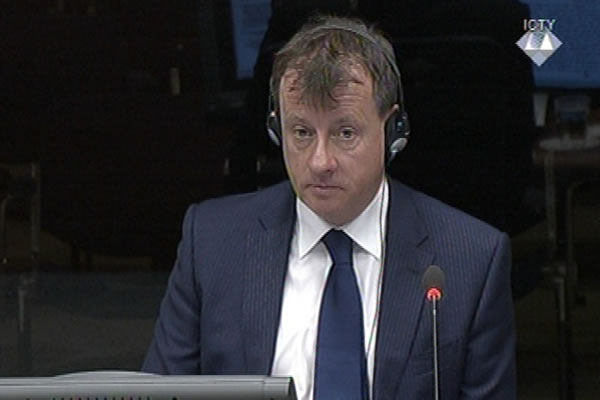Home
(UN)BIASED TOMASICA EXHUMATIONS
In the cross-examination by Mladic’s defense, forensic archaeologist Ian Hanson agreed that occasional mistakes were possible in the work of his organization, the International Commission of Missing Persons. Such errors could happen in the process of the identification of bodies, Hanson explained, dismissing at the same time the allegation about the bias of his organization in favor of the OTP during the exhumations of the Tomasica mass grave
 Ian Hanson, witness at Rako Mladic trial
Ian Hanson, witness at Rako Mladic trial In the cross-examination of the prosecution expert Ian Hanson, Ratko Mladic’s defense attempted to highlight procedural errors in the exhumations of bodies from the Tomasica mass grave near Prijedor. The defense also tried to contest the authority of the International Commission of Missing Persons where the witness works as a forensic archaeologist. Yesterday, in the examination-in-chief, the witness said that from September to December 2013 he was involved in the exhumations of 401 groups of remains of civilian victims from Prijedor found in the Tomasica grave. The witness worked there together with representatives of the police, prosecution and the Missing Persons Institute of Bosnia and Herzegovina. Hanson drafted an expert report for Mladic’s trial.
Defense counsel Branko Lukic noted that in her report another prosecution expert, biologist Elmira Karahasanovic, said that items from Tomasica had arrived to her office for analysis improperly packaged in plastic bags. When the defense counsel suggested that it was a procedural mistake, the witness replied that the Prijedor police crime technicians played the main role in the ‘chain of custody’ of recovered items.
The defense counsel brought up a former official of the Missing Persons Institute of Bosnia and Herzegovina, Jasmin Odobasic. After he parted ways with the organization, in his statement to the OTP in The Hague Odobasic criticized its work as well as the witness’s organization. According to Odobasic, both organizations made mistakes such as misidentifying the victims. Also, Odobasic alleged that Hanson’s organization bribed a Bihac police officer to keep quiet about their mistakes. The witness replied that he knew practically nothing about Odobasic’s allegations because they related to the period before his employment in the IMPC. Hanson agreed that unintentional errors were possible in the identifications of bodies. That could happen especially when there was no DNA analysis but when bodies were identified based on recognition, clothes and exhumed items, Hanson explained.
The defense counsel referred to the witness’s conclusion that since no weapons, uniforms or military items were found next to the bodies, the people buried in Tomasica were civilians. Soldiers were not buried with their weapons, the defense put it to the witness. The witness replied that in his experience it did occur in some cases. For example, the witness explained, fighters with arms and ammunition were exhumed from a grave on Mount Ozren. The defense counsel went on to allege that in 1992 the Muslim soldiers in BH didn’t even have uniforms and it was possible that they were buried in civilian clothing. Hanson didn’t comment on that.
In the defense’s view, the witness was biased because he mostly cooperated with the OTP in Sarajevo and in The Hague. Hanson replied that the primary task of the International Commission on Missing Persons was to collaborate with the BH authorities. As a matter of course, the OTP was often the channel of communication because recovering bodies was usually carried out as part of an investigation. Also, in the re-examination the witness noted that on several occasions he worked together with the defense teams of the accused as a consultant.
In the second part of the hearing today, ballistic expert Bruno Franjic began his evidence.
